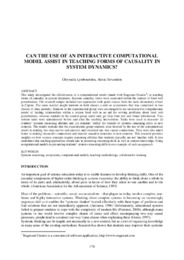| dc.contributor.author | Lymbouridou, Chrystalla | en |
| dc.contributor.author | Sevastidou, Alexia | en |
| dc.coverage.spatial | CY - Λευκωσία | en |
| dc.creator | Lymbouridou, Chrystalla | en |
| dc.creator | Sevastidou, Alexia | en |
| dc.date.accessioned | 2016-02-26T06:23:01Z | |
| dc.date.available | 2016-02-26T06:23:01Z | |
| dc.date.issued | 2003 | |
| dc.identifier.uri | http://hdl.handle.net/10797/14794 | en |
| dc.description | Περιέχει το πλήρες κείμενο | el |
| dc.description.abstract | This study investigated the effectiveness of a computational model (made with Stagecast Creator1) in teaching forms of causality in system dynamics. Systems causality forms were examined within the context of food web perturbations. The research sample included two equivalent sixth grade classes from the same elementary school in Cyprus. The same teacher taught students in both classes a unit on ecosystems that was completed in two lessons (4 class periods). Students in the experimental group were encouraged to use an interactive computational model of feeding relationships within a certain food web as an aid for solving problems about food web perturbations, whereas students in the control group could only get help from text and visual information. Two written tasks were administered before and after the teaching intervention. Tasks were used to measure: (i) students’ systems reasoning abilities and (ii) students’ ability for transfer of systems reasoning skills in new contexts. The results indicate that the experimental group students were favored by the use of the computational model in making two-way (active and passive) and extended one way causal connections. They were also much better in making interactive connections and transfer causality structures in new contexts. This research provides insights on how science concepts require reasoning abilities that students typically are not familiar with. It also underlines that teaching approaches should aim at promoting reasoning skills as well as content knowledge. Using computational models in promoting students’ systems reasoning skills is one example of such an approach. | en |
| dc.language.iso | eng | en |
| dc.publisher | Department of Educational Sciences, University of Cyprus | en |
| dc.relation.ispartof | Teaching and learning | en |
| dc.rights | info:eu-repo/semantics/openAccess | en |
| dc.rights | Open Access | en |
| dc.source | CBLIS Conference Proceedings 2003 Volume II: The educational potencial of new technologies | en |
| dc.title | Can the use of an interactive computational model assist in teaching forms of causality in system dynamics? | en |
| dc.type | info:eu-repo/semantics/conferenceObject | en |
| dc.subject.uncontrolledterm | Systems reasoning | en |
| dc.subject.uncontrolledterm | Ecosystems | en |
| dc.subject.uncontrolledterm | Computational models | en |
| dc.subject.uncontrolledterm | Teaching methodology | en |
| dc.subject.uncontrolledterm | Collaborative learning | en |
| dc.contributor.conferenceorganizer | Learning in Physics Group, University of Cyprus | en |
| dc.contributor.coordinator | Constantinou, Constantinos P. | en |
